

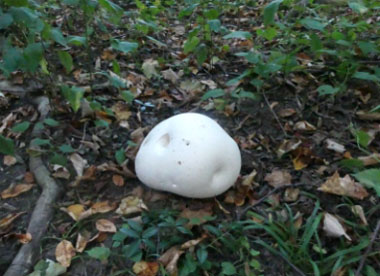
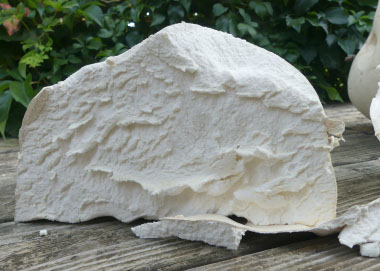
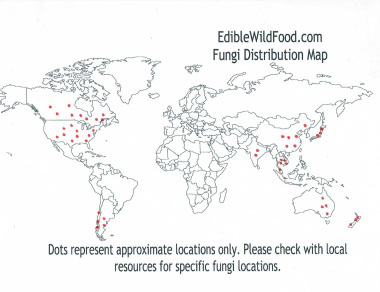
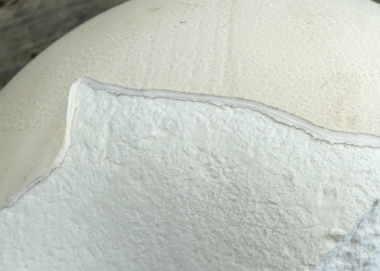
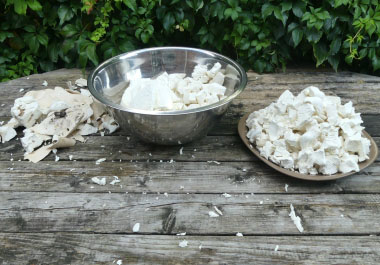

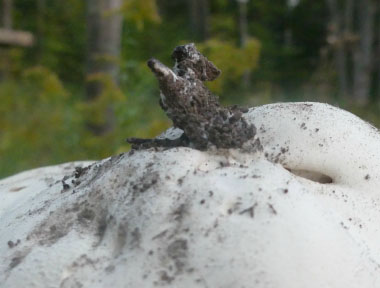

Do not eat any fungi that has not been properly identified by a qualified professional, some are DEADLY when ingested. All edible wild fungi MUST be cooked.
The giant puffball typically grows in width and height anywhere between 10 and 70 cm (about 4” to 27”) and can weigh several kilograms. It has and continues to be been a great source of food for many people worldwide. Historically, it was used by the Iroquois and Meskwaki for food. In addition to being a source of food for centuries, the giant puffball was valuable as a styptic dressing to stem the bleeding of wounds. The giant puffball can be found growing as a solitary entity, in small groups, and they have been known to form large circles.
Type
Distinguishing Features
Calvatia gigantea are easy to spot, although from a distance they could be mistaken for a volleyball. Young giant puffballs have a white, fleshy interior. The flesh of a puffball is called the gleba, and when immature (and edible), it is pure white and has the texture of marshmallow. Once mature the gleba’s colour changes to yellow and brown and it should not be eaten at this stage because of its poor taste and possible toxicity. They develop trillions of spores at this stage of its life and the exterior will eventually crack to release these spores. This process is usually expedited by weather conditions, wildlife and of course, us.
Height
The giant puffball can grow anywhere between 10 and 70 cm (about 4” to 27”).
Habitat
This puffball is often found at the edges of fields, and in rank vegetation in nutrient-rich waste ground and on woodland edges. Although not common, the giant puffball is found in open woodlands. Giant puffballs grow in many locations throughout Canada, the US, Europe and Asia.
Spore Print
Olive brown. According to a student researcher at Cornell University, it was calculated that a single 25cm (10”) giant puffball has 7 trillion spores. If each of those spores grew and yielded a 25cm (10”) puffball, the combined puffball mass would be 800 times that of the earth.
Season
Late summer into mid autumn depending on location.
Gills
No gills.
Edibility
Always cook before eating or dehydrate. The taste is rather faint, yet there is a pleasant scent. Some simple rules must be followed before eating a giant puffball or any puffballs. The interior tissue must be uniformly white. If infested with insects/maggots it should be trimmed in order to avoid the infested parts. The outside skin is easily peeled and should not be eaten if it is tough, leathery, or dirty. Never wash the puffball with water as it will soak up water like a sponge and become very soggy. This and other edible puffballs can be stored for up to 5 days in the refrigerator without losing significant quality.
To support our efforts please browse our store (books with medicinal info, etc.).
Winter Survival Food Handbook

PDF Plant Magazines
Types of Wild Food
Geographic Zones Seasons
Disclaimer
EdibleWildFood.com is informational in nature. While we strive to be 100% accurate, it is solely up to the reader to ensure proper plant identification. Some wild plants are poisonous or can have serious adverse health effects.
We are not health professionals, medical doctors, nor are we nutritionists. It is up to the reader to verify nutritional information and health benefits with qualified professionals for all edible plants listed in this web site. Please click here for more information.
Why Edible Wild Food?
- Food costs are rising
- Free, wild food is readily abundant
- Wild food adds nutrition to your diet
- Wild food can help treat various medical conditions





